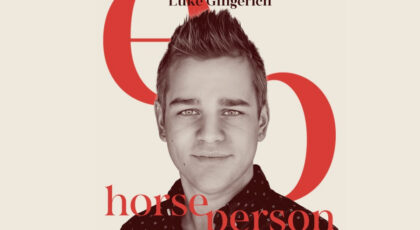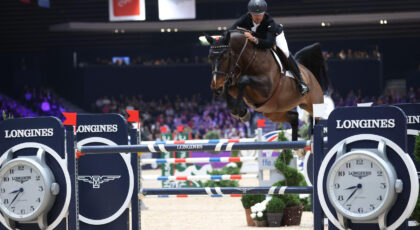No matter what sort of treatment you choose when your horse injures a tendon or a ligament, the most important treatment will be time.
TRIVIA TIME! Who said, “Time Heals All Wounds.” Answer? Well, nobody, at least not exactly. English poet Geoffrey Chaucer wrote in “Troilus & Criseyde” (in Middle English, of course!): “As tyme hem hurt, a tyme doth hem cure.” Even earlier, the Greek dramatist Menander (342 BC- 291 BC) said (in Greek), “Time is the healer of all necessary evils.”
And, if your horse has hurt a tendon or ligament, there’s one thing to keep in mind. At this point in time, no treatment has been shown to be more effective or quicker than controlled rest and rehabilitation in giving a horse with an injured tendon or ligament a chance to return to full function.
That’s right; no matter how eagerly you sweat, magnetize, “shockwave,” or stem cell or laser or compression pump or bandage your horse’s injured tendon or ligament, if you don’t also give your horse adequate time for rest and rehabilitation, all of the expensive—and quite probably unnecessary—other stuff won’t matter at all.
Tendons and ligaments are a bit like ropes. That is, they’re one big cord made up of a lot of little cords (take a look at the illustration, below, and you’ll see what I mean). And, when some of those fibers tear, it causes pain and inflammation, which you see as pain when the swollen area gets squeezed (be careful!), lameness, and swelling. All of which stinks. And you’re going to be in for something of a long haul.

BY THE WAY: The common name for a tendon injury is a “bowed” tendon. That’s not because it gets wrapped up like a present by caring owners, it’s because the tendon swells out sort of in the shape of an archer’s bow.
Anyway, prior to the advent of all of the technology and treatments that have come along in the past three decades or so, rehabilitating injured tendons and ligaments was mostly along the lines of throwing the horse out to pasture for a year or so, coming back, and seeing what you ended up with. If you had a mare, in addition to a healed tendon or ligament, sometimes you also ended up with a foal, because what the heck, as long as the mare was standing out in pasture anyway, she might was well be doing something useful, like having a baby. And, many times, after six months or a year or so passed, what you were left with was actually a pretty good outcome.
Which is something to consider really, and particularly when you consider all of the stuff that’s done to injured tendons and ligaments. That is, many (most?) tendon and ligament injuries turn out just fine if you don’t do much of anything at all.
But they don’t always turn out fine (which is one of the reasons I don’t advocate doing absolutely nothing).
If you didn’t already know, horses are not exactly the best patients, and they don’t begin to care about adhering to a veterinarian’s suggestions, much less understand them (they’re even worse than some owners).
Sometimes, when a horse with an injured tendon or ligament got turned out, he just ran around on his injured ligament, constantly re-injuring it, and making things worse. So, while turning a horse with an injured ligament or tendon out for a year was nice insofar as not having to bother with things was concerned, it could also result in a not-so-good outcome. And a good outcome is what we’re all hoping for, right?

Tendon ultrasound in which the suspensory ligament appears to be messed up.
In the 1980s, diagnostic ultrasound machines started to come into use, and they’ve become a very commonly used part of the rehabilitation process in many horses.
Ultrasound machines allow veterinarians to “look inside” tendons and assess the amount of damage. which is really nice initially, insofar as giving some sort of prognosis goes. Ultrasound machines also allow veterinarians to follow along as healing progresses, which is nice, too.
However, serial ultrasound exams can also be expensive. Frankly, I’ve managed plenty of horses back to soundness without them, mostly due to cost concerns. And I’m OK with that, too, even though, honestly, I think it’s ideal if you can follow the healing process along. Of course, life is not always ideal, and as long as people are willing to give injured tendons and ligaments time—even if it’s more time than may be needed—and are willing to watch over the rehabilitation process, most tendon and ligament injuries have successful outcomes, at least for show and companion horses (racehorses are a different kettle of fish—a tendon or ligament injury is often career ending).
So here’s what to expect if you horse injures a tendon or ligament.
For injuries, that is, the ones that aren’t super severe, horses should appear fairly pain-free in three to eight weeks, which is about the same time frame as occurs with human athletes that have injured their tendons or ligaments. But the horse isn’t ready to go back to work at this point. In fact, if you return a horse with a tendon or ligament injury to to work too early, he runs a huge risk of reinjury.
And there’s another reason not to rush things. The problem with tendon and ligament injuries is that when a re-injury occurs, you generally go back to square one, sort of like happens when you get really unlucky in a game of Chutes and Ladders and have to slide all the way back down to the beginning of the board. That is, if your horse re-injures a tendon and ligament injury, you have to start the whole rest and rehabilitation process all over again.
So, my first rule, when it comes to trying to get an injured tendon or ligament to heal, is that it’s better to be a little prudent and cautious, and take an extra month, than it is to hurry your horse back to the ring, and end up needing another six months or nine months in addition to the time that you’ve already put in.

Dr. Carol Gillis, a wonderful veterinarian and ultrasound expert, who used to be at the University of California, at Davis, CA, but is now out on her own in South Carolina, developed a rehabilitation program that’s fairly well-known, and well-accepted by most equine veterinarians. I think the program is great, and it’s super useful. It not only helps horses, but it gives concerned owners benchmarks, as well as something specific to do.
Dr. Gillis advocates a program of controlled exercise, along with regular ultrasound examinations of the healing limb, in order to help maximize the chance of a successful outcome.
CURIOUS ASIDE: Complete rest is actually pretty bad for rehabilitating tendons, at least in the longer term. Tendons and ligaments heal best under mild stress, which is why controlled exercise is best, when it comes to tendon rehab. This fact was first shown in chickens, although I’m pretty sure they were experimental chickens, because nobody to my knowledge does chicken racing, or chicken dressage, or makes chickens run barrel patterns.
Anyway, I think that it makes a lot of sense to follow the guidelines that Dr. Gillis put out. In some sense, you want tendon and ligament rehabilitation to be like the porridge in Goldilocks and the Three Bears. You don’t want the process to you go too fast, and get the horse back to work too early, because you can make the situation worse. On the other hand, if you go too slowly, you’ll waste time and money. I mean, admit it, you will be anxious to get your horse back to work, so why not do things as efficiently as possible?
The general idea of Dr. Gillis’ program is that there’s a period of rest and medication to control the inflammation that occurs with tendon and ligament injuries, followed by a period of controlled exercise, which stimulates the tendon to heal in a fashion where it is as strong as possible. Serial ultrasound examinations are recommended to check the healing progress of the injured area, although, as I said, it is possible to manage injuries without ultrasound if cost is a concern (mostly, you give the horse more time than you think you need).
Rehabbing a tendon or ligament injury isn’t a quick or easy process—successful resolution often takes eight or nine months. But, as it is also said, “All good things come to those who wait!” (OK, I know you’re curious. That saying at least traces all the way back to the Bible—Lamentations 3:25).
Dr. Gillis’ rehab program is pretty much self-explanatory, which is why I haven’t really spent any time explaining it. If you’re like to read the initial article by Dr. Gillis, describing her rehabilitation program in detail, CLICK HERE. It’s excellent, and time tested. Follow her guidelines, or at least a close facsimile thereof, and you’ll give your horse the best chance of making a full recovery from his tendon or ligament injury: no matter what else you choose to do.
This article originally appeared on DoctorRamey.com and is reprinted here with permission.
 About the Author
About the Author
Dr. David Ramey is a 1983 graduate of the Colorado State University School of Veterinary Medicine. In addition to being a full-time equine veterinary practitioner in Encino, California, Dr. Ramey is also an internationally recognized author, lecturer and blogger. Dr. Ramey is a vocal advocate for the application of science to medicine, and—as such—for the welfare of the horse.




 March 6, 2019
March 6, 2019 




























